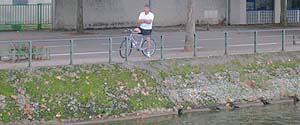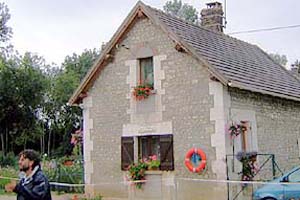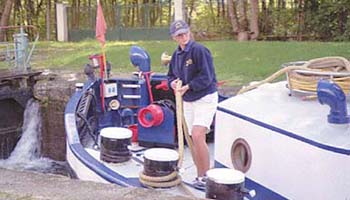The Quest for the Good Life
By Sheila Gaspers
Spring in Paris, as always, promises to rejuvenate and renew even the most worn and wintered spirit. I have always found a sense of inner joy when strolling along the Seine, exploring Paris’ endless arrondissements, or getting my shopping fix at Printemps or the Galeries Lafayette. The city comes alive with colorful and fragrant blooms. For the most observant eye, the shop windows seem to mimic nature, brilliantly dressed with spectacular spring fashions. Paris, the city of lights and love, cannot and should not be ignored or missed. But every savvy traveler must also remember to find balance amidst the bright lights and big city. France extends beyond the Paris city limits. An enchanting, unforgettable escape is only a train ride away. The journey will lead you to France’s most historic canal system (built in the17th Century) and the entry point of the Burgundy Wine Country.
In the 1800’s, the Nivernais Canal was the most important commercial gateway connecting Burgundy to Paris via the Seine and Loire Rivers. Today, the canal is still very critical to the French Economy. Instead of goods from the farm and forest, tourists are the now the treasured cargo. The glorious French countryside beckons to the resident cosmopolitan and visitor alike.
It is the quest for the “Good Life” that draws all to the fertile valleys and river banks of Central and Southern France. This “quest “ is where my story begins.
Barging the waterways, now a celebrated pastime, offers a unique and intimate introduction to French Country Living. France has over 2000 kilometers (1242 miles) of navigable rivers and canals… so mastering the waterway system is not a feat that can be accomplished in one trip. And the journey, as I was soon to learn firsthand, was relaxing and far from boring.
My barging adventure commenced in the small medieval town of Auxerre, a 1.5 hour train ride from Paris. I left Paris late in the day to arrive in town prior to the next day’s morning embarkation. I stayed at the beautifully quaint Le Maxime Hotel located on the banks of the Yonne River just a 20 minute walk from the train station. The hotel was truly charming. With only 25 rooms, you can expect personalized service at an affordable cost. Auxerre, the second largest city in Burgundy after Dijon, is known for its art and history. Following the city’s winding cobblestone streets leads to wonderful architectural finds. Be sure not to miss the Gothic Cathedral and Abbey.
Late Sunday morning, the elegant La Belle Epoquewelcomed passengers. The barge was docked just outside the hotel along the river bank to allow for easy boarding. Smiles and champagne flowed as introductions and greetings were exchanged. With an all British crew, language was not a barrier.
On the canals and rivers, living is “slow and easy.” The barges, which come in all shapes and sizes – from small to smaller, are like floating country inns outfitted with every possible amenity. Most will comfortably accommodate 8-12 persons. Luxury and comfort are top of mind in terms of design and service.
Barge travel is quite different from a large cruise ship experience. The barge glides along at a clip of 4-5 knots (less than 5 miles per hour)…not much faster that the ducks paddling alongside. There are usually no more than 2 decks (kitchen, dining and outdoor deck – above, living quarters and storage – below).
The 12-passenger, La Belle Epoque is one of the largest barges operating on the canal. Measuring 38 meters (124 feet) in length and 5 meters (16.4 ft) wide, she features a full indoor salon, outdoor deck, and a small Jacuzzi.
In terms of onboard entertainment, there are no shows, formal lectures, gambling, or dancing. The barge does offer a DVD player (very limited selection, so bring your favorites) and a small central stereo system in the salon area. Barge trips are booked based on regions of interest (Provence, Burgundy, Upper Loire and Alsace-Lorraine), not specific ports or entertainment value.
It is important to note that each region specializes in certain appellations of wine. There are over 100 appellations. Appellation categorization results from a controlled indexing system of the wine based on the grape, vineyard or region of production. There are regional appellations, communal appellations, Premier Crus, and Grand Crus. This barge trip focused on the Chardonnay grape - Chablis Appellation known as Chablis. (A good website that elaborates on wine appelations is www.terroir-france.com).
Each passenger, when not joining the daily excursion or visiting a local village, often discovers new and forgotten forms of delight and diversion. Many will simply enjoy reading a good book; others test their language skills in friendly conversation, but most simply learn the true meaning of a life of leisure. Gary, an older insurance executive from Alabama, was our most active passenger. He was up bright and early each day prepared to bike or hike the canal towpaths which date back to the pre-power days when horses and oxen pulled the boats. He loved to race the barge and was always the winner pacing 3-4 locks ahead of the boat.
The rest of us eased into the day opting to sip our coffee or mimosa on deck taking in the morning sun, landscaped mirrored waters, picturesque footbridges and grazing white Charolais cattle.
Successfully navigating a lock station, which are still manually operated by a resident lockkeeper, was the ultimate bonding ritual for passengers and crew. Each lockkeeper’s house, family and farm animals were welcomed sights. The houses are unique -- tiny stone edifices adorned with colorful flower boxes and signature plaques. And, it is not unusual to have a dog, goat, or flock of geese inch up to the barge in search of a breakfast croissant or treat. A fresh basket of muffins, cakes or breads were always offered as a “thank you.”
Excitement brewed as we made each approach. The Captain steered her in steady and safely despite the narrow widths. Ropes were secured and the water levels rose or dropped to keep us on course.
The highlight of any barge trip is, by far, the gourmet food and wine. The cheese selection alone is mind-boggling. Some say there is a French cheese for every day of the year. Amidst the hundreds, I managed to find my favorite, Brillat-Savarin, soft triple cream cheese produced from cow's milk. Even after countless tastings, I was far from satisfied. Learning that Brillat-Savarin pairs perfectly with a glass of chilled Champagne did not help curtail my new food obsession. Epoisses, said to be created by the Cistercian Monks, is the better known cheese. This local Burgundy mainstay is also made from cow's milk. But is it is unique in that the cheese is washed in the distilled spirit of crushed grapes giving it a distinctive orange-red color and taste.
Every meal is a personalized gastronomical work of art by a trained chef. You will never go hungry. Breakfast features a buffet of fresh pastries, breads, fruit, cheeses, cold cuts and cereals. Cooked to order eggs or omelets are available upon request. Lunch and dinner showcases the food and wine of the region. All menu ingredients are “fresh & local” purchased in the village markets along the way.
French favorites like Beef Bourginon, Rabbit à la dijonnaise, Burgundy Snails, Duck Confit, and Foie Gras made each evening’s five- course culinary presentation a savory and memorable experience.
When not indulging in fine food and wine, we were whisked by mini bus to visit local vineyards, discover hidden cellars, tour chateaus, churches, sacred ruins, and wander ancient villages.
One of our first stops just outside of Auxerre, was the Caves de Bailly in Saint Bris, a deep underground cellar which was originally a quarry. This impressive cellar is best known for Crémant de Bourgogne, a unique sparkling wine that is made via the ancient champenoise method. Crisp, clean and fruity in taste, Crémant de Bourgogne is now recognized as one of the finest bubbly bruts in France outside of Champagne region. And, at a price of $15 per bottle, it was my best barge buy.
But alas, in Burgundy, no sparkling or white wine is complete without a touch of cassis (blackcurrant liqueur). It was Canon Kir, Mayor of nearby Dijon, who made 'blanc-cassis' the official aperitif of all the town hall receptions. His parties obviously put it on the map worldwide (hence the drink’s recognized name “Kir”).
The afternoon excursion allowed us to explore more of St Bris, an ancient town known for its extensive network of underground passages. Saint Bris was built in such a way that it could house all its inhabitants underground during the time of a siege. We were treated to a wine tasting in the historic Bersan Family Cellars, built under the town’s original 12th Century fortifications. Hundreds of wine bottles covered in cobwebs and mold reminded us of the rich soil and heritage of the region.
Still vivid in my mind is our journey to the mystical town ofVézelay, a sacred pilgrimage destination, set on a hilltop overlooking the pastoral Burgundy countryside. Vézelay is best known for the Roman Basilica which is said to house a relic of the remains of Saint Mary Magdalene.
It has also has a strong historical association withRichard the Lion-Hearted, St. Francis of Assisi and the Second Crusade. My visit was touched by faith and emotion, knowing that thousands of pilgrims had traveled over the same cobblestone streets centuries before me.
Clamecy was the final stop of the final barge tour before our transfer back to Paris. The city, an old logging port, is best known for its world-renowned annual floating log competition. A statue of Jean Rouvet, Father of the Flotteurs, stands proudly on the Bethelehem Bridge.
The days passed too quickly. How could anyone return to reality? The cheese withdrawal alone would kill me.
I knew I would be back again very soon. There was still the Côte de Beaune… the Côte de Nuits… and the Côtes de Provence! So much wine and so little time!
I do have tips to share:
-- Choose your barge based on your interests and favorite wine…or you will be disappointed. If you love wonderful pinot reds…a cruise to Chablis will not be a match.
-- Time of Year and Season can critically impact your overall experience. Spring is refreshing; Summer can be crowded; Fall can be wet and cold.
-- Explore Theme Barge Trips or Charters. It’s all about the company you keep. Traveling with friends or those who have a shared interest can enhance the overall barge adventure.
-- Bring along several good books/magazines to read and share. I would also bring along a fun DVD (perhaps…Sideways?) for the night where you just want to relax and sip a good Pinot.
Rates for six-night/seven day cruises range from $4550 to $5490 per person. Price includes accommodations, open bar/wine, gourmet meals, and local transfers. Tips are additional (3% of Cruise Cost). Charters are also available.
For more info visit: GoBarging.com or call toll free 877-879-8808.











